

 The Accurate Reloading Forums
The Accurate Reloading Forums  THE ACCURATE RELOADING.COM FORUMS
THE ACCURATE RELOADING.COM FORUMS  Guns, Politics, Gunsmithing & Reloading
Guns, Politics, Gunsmithing & Reloading  Reloading
Reloading  An aberration documented
An aberration documentedGo  | New  | Find  | Notify  | Tools  | Reply  |  |
| One of Us |
Last November I had an aberration in recording velocities. I shrugged it off, because things like that have happened over the years, and they don't seem to repeat. I would typically assume that the chronograph had a mis-read for any number of reasons. However, last November's aberration was recorded by two chronographs in serial simultaneously. A three shot group was fired of 98.0 grains H322 450grain GSC bullet in a .510 AccRelNyati rifle with a 22" barrel. The double chronograph readings were as follows: shot#, chrono 1, chrono 2 shot 1. 2759 , 2749 shot 2. 2544 , 2543 shot 3. 2564 , 2554 The chronographs recorded a 200fps jump from the same load. (I say 'jump' because the load was expected to produce a velocity between 2500-2600fps, just like the other two shots. The high velocity was far above expectations.) What could have caused such a jump? And the speed is a serious load. That would be a 7600 foot pound muzzle energy, up from 6500ft pounds. The 500AccRel should be able to handle such power, marginally, but it was not my intended goal at the time. I do not remember feeling a recoil difference (or noticing a difference in extraction or primer), but then again, I don't usually remember much of anything a split-second after firing the 500. Attached is a picture from the same firing session, though a different grouping, a lighter bullet, also attached. Recoil of 500:  Group with 360gnCEB, 96.0 H4198, 2822 average fps.:  The pictures document the double chrono setup, and the group tends to support that I knew what I was doing, and that I wasn't delusional during the session. So it remains a mystery to me that might receive some elucidation from this forum. +-+-+-+-+-+-+ "A well-rounded hunting battery might include: 500 AccRel Nyati, 416 Rigby or 416 Ruger, 375Ruger or 338WM, 308 or 270, 243, 223" -- Conserving creation, hunting the harvest. | ||
|
| One of Us |
There is one spot for human error to enter the above conundrum and I hope to check it out next week. I would walk out to the chronographs after each shotin order to read both of the machines and would then record the numbers by hand at the bench. I noted the aberration at the time but I do not remember whether or not I cycled back and verified the numbers in the machine's memory. I can do that later next week. As I said, I have seen numbers like that on single machines in that past, and now I am wondering what might be the causes for such velocity jumps. +-+-+-+-+-+-+ "A well-rounded hunting battery might include: 500 AccRel Nyati, 416 Rigby or 416 Ruger, 375Ruger or 338WM, 308 or 270, 243, 223" -- Conserving creation, hunting the harvest. | |||
|
| One of Us |
Maybe/possibly ? a lubed bore on the first shot ? | |||
|
| One of Us |
To much sun ________________________________________________ Maker of The Frankenstud Sling Keeper Proudly made in the USA Acepting all forms of payment | |||
|
| One of Us |
Did the case show PSI signs from the first shot? | |||
|
| One of Us |
Not uncommon for the first shot to be different. It happens and you will never know why. | |||
|
| One of Us |
I remember a similar incident when shooting a 6.5X55 years ago - 200+ fps variance on that occasion. The only variance in the shots was that I brushed the bore before the first shot. I did not use a patch but just used a bronze brush. I do not know if that makes sense or is relevant ????? "When the wind stops....start rowing. When the wind starts, get the sail up quick." | |||
|
| One of Us |
While the aberration may well be cartridge related, the fact that you had two chronographs in series does not necessarily eliminate the cause being the chronographs. If one chronograph has a propensity under the conditions prevailing on the day to throw a bum first shot then it might well be expected that a same model chronograph in series could match this, it does looks like same models in your photo. Had your chronographs been different types or models then at least you would be eliminating this factor. When I use my chronograph or any other electronic tool I switch it on quite a while before I use it to allow the electronics to stabilise. I believe the aberration was most likely bore or cartridge related but scientifically you cannot eliminate the chronographs | |||
|
| One of Us |
Well, the aberrant reading was not the first shot of the day, because I didn't start with the 500. However, it MAY have been the first of the series when we started with the 500, I can't remember. And yes, I believe that the two were the same model. I have three chronos, and one is different, but they all look similar at a distance (none was a Chrony, which I've also used with success). +-+-+-+-+-+-+ "A well-rounded hunting battery might include: 500 AccRel Nyati, 416 Rigby or 416 Ruger, 375Ruger or 338WM, 308 or 270, 243, 223" -- Conserving creation, hunting the harvest. | |||
|
| One of Us |
Do you notice any muzzle blast effects on the chronograph or sight screens? I do at the range you have the chronograph from the muzzle. Get spurious values and sometimes blows the screens off (even more so when a 'guest' shoots the wire supports). Especially with large volumes of powder with the 50 caliber. Graeme Wright built a blast baffle for his Oehler and features it in his book Shooting the British Double Rifle. Cheers, Chris DRSS | |||
|
| One of Us |
+1 Re-check on partly overcast day. _______________________ | |||
|
| One of Us |
My screens have always been pretty stable since I place the machines 20 feet from the muzzle. I've sometimes done 30 feet, but not usually these days. Yes, an appropriate angle from the sun might have explained the errant velocity, though the GSC bullet is covered in a dull-to-our-eyes, dark, non-moly coating. These are not shiny projectiles. There is no doubt, though, that the load is a 2550-fps-level load. My questions are whether the aberrant velocity was real or apparent. Either way, I wouldn't expect to duplicate it. +-+-+-+-+-+-+ "A well-rounded hunting battery might include: 500 AccRel Nyati, 416 Rigby or 416 Ruger, 375Ruger or 338WM, 308 or 270, 243, 223" -- Conserving creation, hunting the harvest. | |||
|
| One of Us |
Assuming nothing changed in the rifle or bore, lets look at some other candidates for the anomaly. Redundant chronographs - If that model of chronograph were to make a 9% error once per 500 shots then the probability of two of them doing it at the same time is 1 in 250,000. So, while the chronographs may be responsible for the error, it is unlikely. Case - If the case was of different manufacture it could have a smaller internal capacity. Some sort of manufacturing defect leaving the case with lesser internal capacity is also possible even if unlikely. Tell us about the case. Primer - I don't know of any way a 'hot' primer could account for the difference, assuming there are 'hot' primers. But differences have been observed when shooting with different primers. These differences are generally 25-50 fps at most . The .510 AccRel Nyati is a big cartridge and perhaps larger variations can occur. I have no experience with such large cases and do not know if a primer difference can cause 150 fps variation in velocity. Tell us about the primers. Bullet - My first thought was that there might have been an internal void in the lead core of the bullet. But the bullets you were using are homogeneous metal bullets and anything less than homogeneous is very unlikely. An out of spec variation in the shape or dimensions is still possible. Have you tried measuring some of those bullets? Powder - The powder was from the same source for all cartridges, correct? A variation or error in the amount of powder loaded into the shell can have a significant effect on velocity. Perhaps this one cartridge, for some reason or in some way, received a bigger charge of powder. This is not an uncommon error, even for experienced loaders. A measuring error could be due to method, equipment, or human error. I believe this is the most likely cause of the anomaly. Tell us how you measure powder and charge your cases. Murphy - If something can go wrong...... Well, you know the saying. What happened could have been the result of a little bit of any or all of the above, and other things as well, working together to come against you by chance. . | |||
|
| One of Us |
Nothing went "wrong". If this was your first shot from a clean or slightly oily barrel, then it can happen. Sun? Too much sun on the photorecepters makes the bullet hard or impossible to see. I have never had it cause high velocities. A 200 fps variance in such a huge cartridge is basically impossible any other way without showing high pressure signs. Was it real? Do you trust your chrono? . | |||
|
| One of Us |
Instrument error. These chronographs are sensitive to where the bullet flew over the sensors, sunlight on the sensors, gunpowder particles crossing the screens. If you are getting impossible velocities and not showing pressure indications, then it is instrument error. It is my recollection that when I ran my greased bullet tests I encountered aberrant velocities. I wanted to see how velocity might change given that I was greasing these bullets as was commonly done back in the cupro nickel era. As you can see I really slathered the grease on the cartridges and most of that grease was blown out of the barrel. Some of it was squeezed back into the action. Huge grease plumes confused the sensors on the chronograph and I had to move the thing out to allow the grease plume to dissipate before it got to the chronograph. 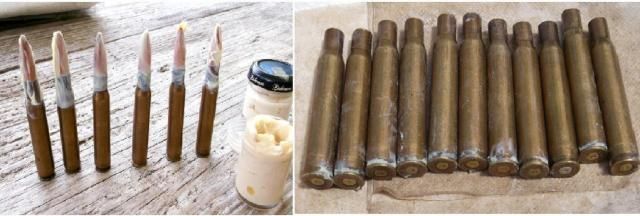 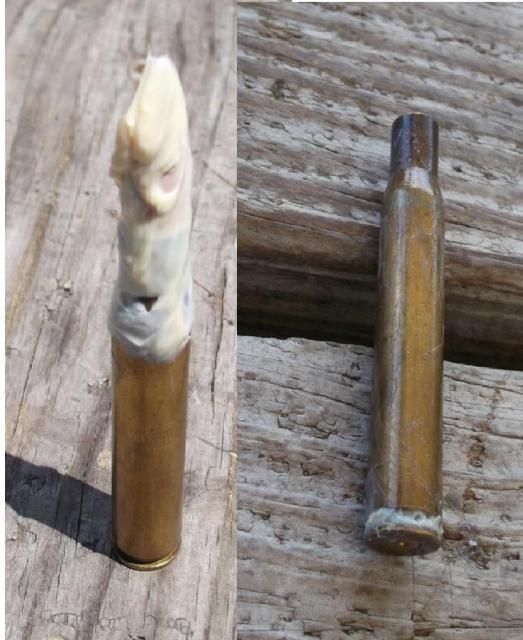 | |||
|
| One of Us |
For the new shooter or reloader; never coat your bullets with grease, oil, or anything else. This is a very good example of what not to do for some very good safety reasons. Mr Slam is very lucky he didn't bulge a barrel, and getting varying velocities is par. | |||
|
| One of Us |
I still doubt it was the chronographs (multiple). Look at that 1" shot group. If the rifle rest wasn't moved and the target wasn't moved and the chronographs were not moved then each of those three bullets would have traveled virtually the same path through the chronographs. You have bright sun and the lighting couldn't have differed much, if any, between the three consecutive shots. Yes, there could have been particles but it would have taken a good bit and the two chronographs would have registered differently. Remember he shot this through two chronographs. It is highly unlikely the same exact "instrument error" occurred in two separate chronographs at the same time. . | |||
|
| One of Us |
Greasing bullets was very common during the era of cupro nickel bullet jackets. We know from the historical record that the Austrians issued steel case bullets that were covered in grease and we know the Swiss issued bullets with grease rings. One reference I have claims that the Italians and the Russians both issued ammunition similar to the Austrians, that is greased steel bullets. I also know Austrialian target shooters were firing greased bullets prior to WW2. Greased bullets went by the wayside once non fouling bullet jacket materials were developed. I have not seen any evidence of high pressures, strange velocity problems, or inaccuracy with greased bullets. It is messy as heck. These rounds were fired as sighting shots, to zero rifle. Bullets and chamber absolutely free from grease. 30-06 M98 Match Rifle 26" 1-10 Wilson Barrel 168 gr Nosler Match 47.0 IMR 4895 thrown lot L7926 LC53 WLR (brass) OAL 3.30" 13 Aug 2014 T = 80 °F Ave Vel =2619 Std Dev =29 ES = 72 High = 2644 Low = 2572 N = 5 I subsequently shot a group which the bullets were not greased, but there was most certainly some grease residue left in the chamber from previous rounds. 168 gr Nosler Match 47.0 IMR 4895 thrown lot L7926 FA60 CCI #34 OAL 3.30" grease in chamber from greased rounds 13 Aug 2014 T = 80 °F Ave Vel =2691 Std Dev =30 ES = 81 High = 2742 N = 7 Group Size: 9 rounds on target. 89-4X on MR 31 target 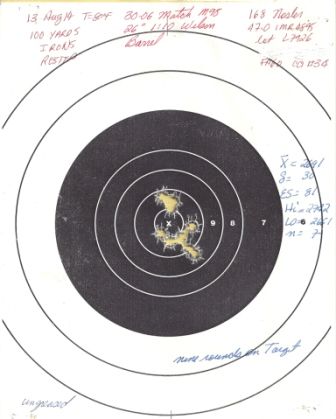 168 gr Nosler Match 47.0 IMR 4895 thrown lot L7926 FA/LC cases WLR (brass) OAL 3.30" Greased to case shoulders by dip and twist with Lubriplate AA130 13 Aug 2014 T = 80 °F Ave Vel =2650 Std Dev =16 ES = 46 High = 2675 Low = 2629 N = 8 Shot #5: grease beyond case shoulder, Shot #8 very heavily greased, 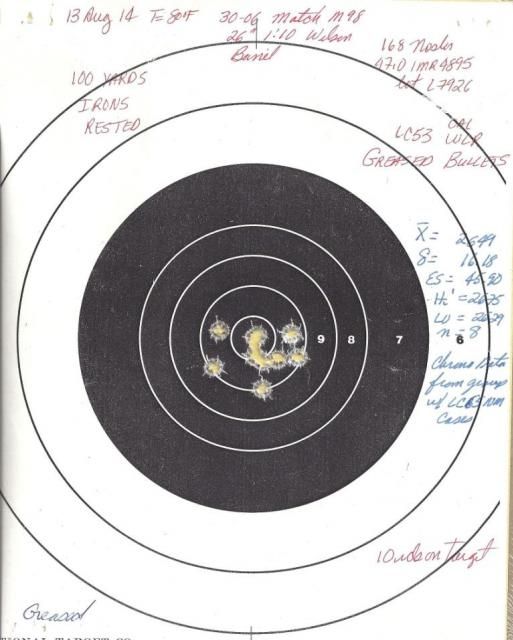 | |||
|
| One of Us |
One potential problem as I see it is that with grease all over the cases as well as the bullets, the cartridge case cannot grip the chamber walls, so ALL pressure is translated into rearward thrust, putting untold stress on the bolt face and locking lugs. Jon Larsson - Hunter - Shooter - Reloader - Mostly in that order... | |||
|
| One of Us |
The .7" group was shot on the same day, either before or after the group with the velocity aberration which was with a different bullet. And the aberration was not the first group of the barrel. Was the barrel "cleaned"? I don't know. But not fully cleaned since it was in the middle of a range session. I sometimes run a single wet patch and then a dry bore-snake thru barrels at the range for a partial clean after 10-20 shots. +-+-+-+-+-+-+ "A well-rounded hunting battery might include: 500 AccRel Nyati, 416 Rigby or 416 Ruger, 375Ruger or 338WM, 308 or 270, 243, 223" -- Conserving creation, hunting the harvest. | |||
|
| One of Us |
Some fuller data on the loading procedures: On CASES: all cases for the 500 are "Quality Cartridge". The aberrant group was loaded in 'twice-fired" cases. The group just before the aberrant group was in 3-times fired cases. PRIMERS: All primers were Winchester LRMagnum, purchased in 2015. POWDER: All groups with the 450-grain GSC bullets were loaded with H322 powder from the same batch. (The other bullet tested that day [producing groups .7" to 1.3"] was a CEB 350-grain Raptor and those loads that day were with H4198 powder). Previous group to aberrant group: Before the aberrant group, a group with the 450 GSC bullet was shot with 96.0 grains H322. The 96.0 grains produced an average chrono reading of 2518fps [correctable to 2534 muzzle]). This was very close to what was expected with two of the shots with 98 grains. As reported above, those 98-grain-H322 shots averaged 2551fps readings (and would be corrected to 2567fps muzzle velocity), with the super-high reading thrown out. +-+-+-+-+-+-+ "A well-rounded hunting battery might include: 500 AccRel Nyati, 416 Rigby or 416 Ruger, 375Ruger or 338WM, 308 or 270, 243, 223" -- Conserving creation, hunting the harvest. | |||
|
| One of Us |
All the usual suspects: I agree that a bullet so heavy at moderate velocity should not jump 200fps. So I am assuming that the velocity was virtual and not real, especially without a credible explanation in the circumstances. I once had a Crony in Africa go "off" and start reading a tested 2820fps load of 416Rigby (350TTSX) at around 3000fps+. Nothing seemed to change except those chronograph readings. (We were trying to chronograph a lighter load, aiming at 2650-2700fps, but it too, that day, was clocking too fast.) We assumed that one of the sensors had misaligned itself after traveling on bumpy roads across Tanzania and that it was recording a span that was slightly shorter than its intended algorithm, thus producing faster-than-expected readings. We stopped using that Crony after that date (4 years ago). But the aberrant group in this thread only had one too-fast shot, and a double chrono. +-+-+-+-+-+-+ "A well-rounded hunting battery might include: 500 AccRel Nyati, 416 Rigby or 416 Ruger, 375Ruger or 338WM, 308 or 270, 243, 223" -- Conserving creation, hunting the harvest. | |||
|
| Moderator |
what a strange happenstance -- if it was a single chrono, 2 shots read THAT high, i'd tell the guy to change his battery... but in series reading is amazing - Other than "the same external conditions that caused #1 to fail to read properly also caused #2" or straight up human error (not suggesting that), i couldn't begin to guess --- i am fairly certain that this particular bullet at nearly 2800 would have grossly over pressured the case -- to the point of at least primer failure, though i'd have expected even worse opinions vary band of bubbas and STC hunting Club Words aren't Murder - Political assassination is MURDER Information on Ammoguide about the416AR, 458AR, 470AR, 500AR What is an AR round? Case Drawings 416-458-470AR and 500AR. 476AR, http://www.weaponsmith.com | |||
|
one of us |
I would like to use two different chronographs. Jiri | |||
|
| One of Us |
Untold stress?! | |||
|
| One of Us |
Interesting, though puzzling. When I used to use Chrony's it was fairly common they'd give a reading way off. I recall a reading for a 2900+- .243 showing 7700fps. NDW! We all know that was a malfunction. I've never noticed a small misreading, they either read, show about right or way off the charts. I now have a CED M-2, read every shot just right Feb '12. Wouldn't read at all last summer. I'd been sick for two plus years and not used since Feb '12. Out of warranty. I explained my situation to the CED's owner. He said: "send the unit and the sensors back I'll test them". Found one of the sensors had gone bad and replaced it N/C. Two years out of warranty. Can't beat that with a big club and ten helpers! Slamfire: Way back about 1960 or so and uncle gave me about 40+- rounds of '06 steel jackets 240gr RN's from a known source from WWI. He'd had them in a coffee can for many years out in his garage under the bench over 100 degree's many summer days, and way below zero every winter. When he learned I was shooting an '06 he donated them to me. Man, they'd bust big rocks into pieces. Impressive! About the 5th or so shot one just hissed real loud out the side vent hole. I looked down the bore and it was plugged up. Gunsmith said he used an electric hammer on it for hours and gave up. Next day he thought he'd give it one more try before calling to tell me it was ruined. He'd left some kind of penetrating oil sit in it over night. Sure enough after a few minutes it started moving. He said the old powder must have gone bad and for me to pull the rest and reload with new primers and powder which I did. Never another problem with them. Never seen any 240gr bullets in .30 cal since. Greasing them up never crossed my mind. I was just a kid then of course too. Thanks for the input, added education to many of us. Here's a couple money/chronograph saving ideas I've learned the hard way. Replace those wires with wood dowel rods, hit a wire and you very well may destroy the sensors. Especially on face screen types. Get some 1/4" plexiglass and cut a piece to fit the front of your units. I put a BP patch thru one of mine and destroyed it. Before that, I'd seen several powder grain holes in the thin film face. Both of those and a borrowed one were Chrony's. Hope this helps. I fully believe the makers of these things that are in front of the bullet are made that way so they can sell replacements when we destroy them! Sooner or later we or someone else will hit the unit with a bullet. Count on it! Wish you all well. George "Gun Control is NOT about Guns' "It's about Control!!" Join the NRA today!" LM: NRA, DAV, George L. Dwight | |||
|
| One of Us |
Coat those babies with bacon grease and you have one Hell of an anti ISIS round! | |||
|
| One of Us |
Your problem came from old, deteriorated gunpowder. That WW1 era ammunition was around 60 years old and it had to have been badly deteriorated. I have written extensively on the dangerous of old gunpowder. There is a list of problems with old gunpowder, the high points are that it autocombusts in bulk, creates high pressure through burn rate instability, and outgases NOx which will corrode and crack brass cases. Once the stuff gets past 20 years of age problems can occur at any time. As you found, old gunpowder will create pressure problems and there are plenty of gun blows with old ammunition. There is zero profit in educating the shooting community about this, so most shooters just assume their gunpowder, and thus their ammunition, will be perfect forever. The popular press promotes this view with periodic nonsensical articles about the virtues of old ammunition or gunpowder. I really doubt a greased bullet would have fixed anything, what you did was the best: dumped the powder and reloaded with good stuff. There was a huge era of greased bullets, and that was prior to the 1930’s. Cupro nickel bullets fouled something awful. Until you run across these bullets, you don’t know how bad jacket fouling can get. I had a case of 303 British ammunition made by the Iraqi’s. The stuff jacket fouled horribly, leading big, long, lumps of fouling in the barrel. It took weeks of soaking with Sweets to get the lumps level with the rifling. Now if you run across ammunition this bad, then the best thing to do is grease the bullets. Which I did, I carefully greased the bullets only, and then, I got lazy and just dropped grease lumps in ziplock bags and tumbled the whole rounds in the stuff. It was messy as heck, but the jacket fouling stopped. This ad, from around 1919, you could buy Never Nickle Grease, made by the British Firm A. J. Parker, or Mobil Lubricant, which was an axle grease. The picture is of the can used by competitors to dip their bullets. 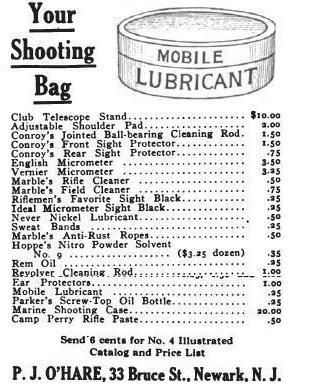 The American Rifleman stated that A. J. Parker was still selling Never Nickel in the late 1960’s. We know from the historical record that the Swiss were issuing greased bullets into the 1980’s. Swiss bullets 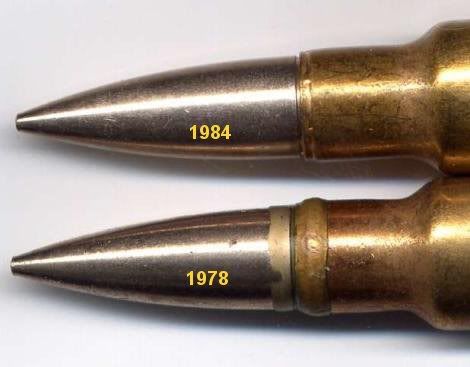 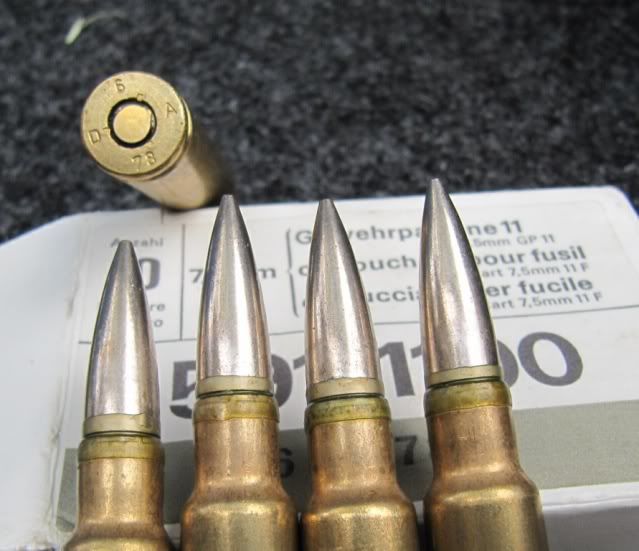 I have read posts on Swiss Rifles.com where it was claimed that the grease ring improved accuracy. In the middle 1990’s a moly lube fad hit the high power scene. David Tubbs and others were shooting bullets coated with molybdenum-disulfide and claiming superior accuracy and great barrel life. This fad has sort of run its course as non greased bullets shoot fine and the barrel life claims for moly lube bullets were impossible to substantiate. What was true was that moly tracked its way from the reloading bench to every surface in your house and was hard to clean off. | |||
|
| one of us |
416 Tanzan, I cannot say that I have ever heard of this before. As you say, it would be best to verify the readings by cycling the chronographs to see if the readings were in fact that high. If you take the other four readings, with a high of 2564 and a low of 2543, the first two fall right in the group of speeds, if the readings are 2559 and 2549. It would be interesting to know the answer to this mystery. | |||
|
| One of Us |
Ta-daaah I've finally returned to where the chronographs have been stored. The mystery is solved. The following shot sequences were in the memory of #1: 66 - - - 2559 67 - - - 2544 68 - - - 2564 Somewhere from the chronograph, to the pen and ink notes on the bench, to the computer input at home, the numbers on the first shot of the group 66-67-68 were mis-recorded. The chrono reading, including the second chrono, can be described as 2552 fps average and a 2567 average muzzle velocity. +-+-+-+-+-+-+ "A well-rounded hunting battery might include: 500 AccRel Nyati, 416 Rigby or 416 Ruger, 375Ruger or 338WM, 308 or 270, 243, 223" -- Conserving creation, hunting the harvest. | |||
|
| One of Us |
So it's human error after all. . | |||
|
| one of us |
Ive noticed it pretty easy to get a bad reading if you don't squat and look directly at the reading as I have read a 7 as a 1 or visa versa on those little screens by looking down at them form an angle.. As to grease on the bullets I would be concerned that the greas would work back on the case and you would get setback and some reloading manuals address this issue..I also notice in Slamfires photos that grease was deposited in the gap at he base of his cases.. Will this damage a rifle I have no idea, or what amount of the added pressure it would cause, just making suggestive conversation.. Ray Atkinson Atkinson Hunting Adventures 10 Ward Lane, Filer, Idaho, 83328 208-731-4120 rayatkinsonhunting@gmail.com | |||
|
| Powered by Social Strata |
| Please Wait. Your request is being processed... |
|

Visit our on-line store for AR Memorabilia

